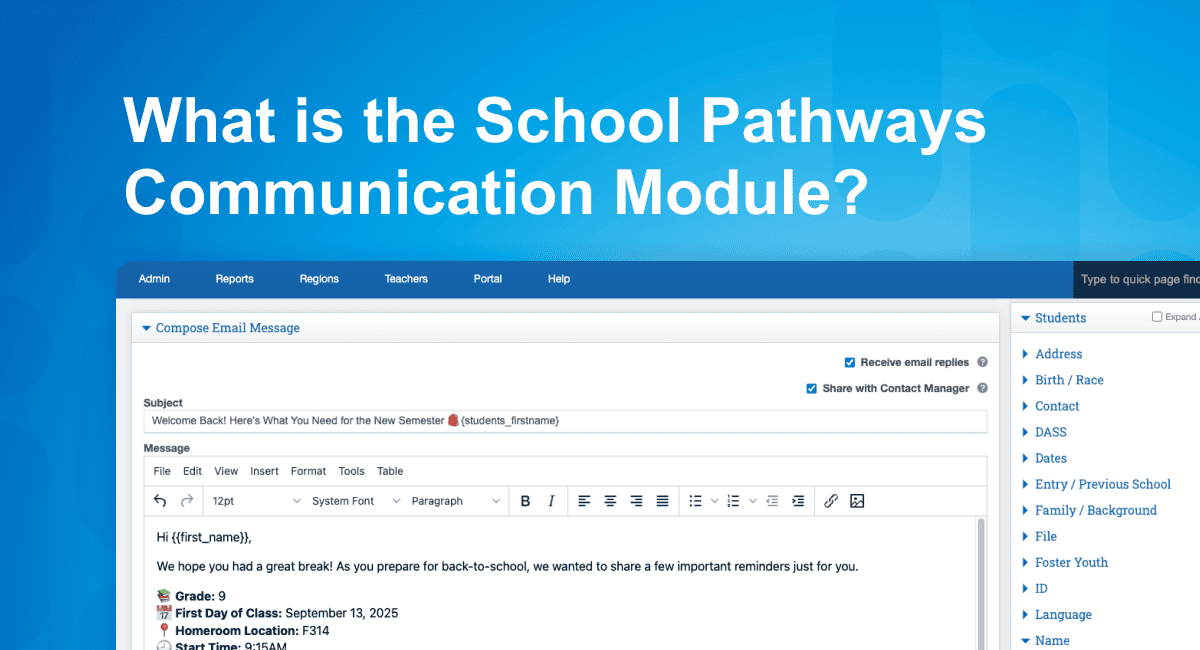Increasingly in K-12 education, parents and students want to choose the educational path that best fits their unique needs and aspirations. According to EdChoice, a nonprofit school choice advocate group, districts in 32 states and Washington, D.C., now offer various forms of educational choice, with local education agencies in more states expected to join the movement. These programs give families a wealth of educational choices, opening doors to diverse learning environments.
However, school choice has a profound impact on district schools, affecting school culture, enrollment, funding, and resource allocation. To address these challenges and implement effective school choice programs, district leaders must understand the impact of school choice on their schools and adapt school selection systems/processes to comply with school choice policies and meet the needs of students and their families. In this article, learn all the must-knows — from defining school choice to how it affects traditional district schools and everything in between.
What is School Choice?
School choice refers to policies that expand educational options for families beyond their traditional neighborhood public school assignment. This policy empowers parents to select schools based on educational philosophy, curriculum, specialization, or even proximity to a family member’s workplace. However, access to these school options varies widely, influenced by factors such as socioeconomic status, geographic location, access to information, and specific program admissions policies.
At times, school choice has sparked intense debate in education policy. Proponents praise the policy for providing families with more educational choices and fostering competition among schools. Critics, however, raise concerns about equity, funding, and potential segregation. Despite the debate, the demand for school choice programs is surging, leading to a nationwide wave of increased legislative support. More states are adopting school choice policies, reflecting the growing interest and support from families across the country. As such, district leaders must be prepared to implement school choice while also explaining the benefits and rationale of choice-based programs to stakeholders in their communities.
Types of School Choice Policies
School choice encompasses a variety of programs designed to expand educational options for families. Programs might include:
- Charter schools: These publicly funded schools operate largely independently of the traditional district structure and often focus on specific educational philosophies or themes.
- Magnet schools: These public schools operate within a district that offers specialized programs or curricula. They welcome students outside their neighborhood boundaries through an application process.
- Voucher programs: Voucher programs give students public funds to attend private, religious, or approved online schools.
- Education Savings Account Programs (ESAs): Similar to voucher programs, ESAs allow parents to deposit public funds into an account to pay for qualified education expenses. The funds can be used for private school tuition or homeschooling materials.
- Scholarship Tax Credit Program: These programs provide tax credits to individuals or businesses that donate to organizations offering scholarships to private school students.
- Individual Tuition Tax Credits: Tax credits are given directly to taxpayers who pay out-of-pocket private school tuition, reducing families’ financial burden.
Beyond these programs, school choice can include options like virtual academies, homeschooling, and open enrollment policies, allowing students to attend schools outside their assigned districts.
The Impact of School Choice on District Schools
From shifting enrollments to evolving school cultures, the impact of school choice can be nuanced and far-reaching. Let’s dive into three ways in which school choice is affecting district schools:
Diversity Impact
School choice can influence the cultural and demographic makeup of district schools. While some critics argue that it can lead to socioeconomic segregation, proponents believe it creates richer diversity within student populations in the programs. Especially as many more families seek schools where equity, diversity, and inclusion are integrated into the school culture and reflected in their peers and staff.
While not every school can meet every need, school leaders who focus on making their schools more accessible and equitable can spark innovation and boost accountability, ensuring that they better meet the needs of students and families.
Enrollment Impact
With the rise of school choice, traditional district schools are facing more competition as students explore and enroll in options like charter schools, private schools, or homeschooling. These enrollment swings can lead to a gradual decline in remaining district school enrollment, causing school leaders to consolidate, repurpose, or even close campuses. However, the degree of change varies greatly, shaped by elements such as the quality of district offerings, community demographics, transportation options, and the school’s reputation.
As all of these choice options expand, district leaders should expect to make decisions that will ultimately create school communities appealing and engaging to families.
Financial Impact
When students opt for school choice options, district schools may face potential budget instability due to the loss of per-pupil funding. However, this shift can drive long-term benefits by encouraging schools to enhance efficiency and innovation to attract and retain students and families.
Research even suggests that school choice programs generate significant fiscal benefits for states and school districts by relieving pressure on their budgets. Out of 73 studies done on the fiscal effects of private school choice programs, 93% found programs generate savings for taxpayers. In all, for every $1 spent on school choice programs, they generate between $1.80 and $2.85 in estimated fiscal savings.
Strategies to Ensure Equitable Access Within School Choice
With the right strategies, districts can create school choice policies and options where every family can make the best decision for their child’s education. Here are some key ways that districts can promote equitable access to high-quality educational choices in their schools:
Enhance School Quality
Quality matters when it comes to serving students and families in the era of school choice. Districts prioritizing a well-rounded educational experience will be better equipped to provide high-quality, equitable education options, ensuring all students receive the support and opportunities they deserve. Key areas to focus on include:
- Offering a range of programs that cater to different needs and interests. This could include STEM programs for students interested in science and technology, arts programs that nurture creativity, or technical training pathways to prepare students for in-demand jobs. Providing more options demonstrates that your district is committed to catering to students and preparing them for success.
- Fostering a welcoming and inclusive school environment. This means celebrating diversity and making every student feel valued, respected, and supported. Cultivating a sense of belonging makes your schools a magnet for families seeking a nurturing and enriching environment for their children.
- Continuously investing in professional development opportunities for teachers and staff to stay at the forefront of educational best practices and address challenges with confidence. Empowered educators can more effectively meet the needs of students and build creative environments where students are engaged and successful in the long run.
Assess Applicant Data
In the school choice environment, data-driven insights will empower districts to make important decisions faster and with greater clarity. As NWEA’s Lindsay Dworkin emphasizes, “It has always been important to understand which programs or interventions are working, for which students, and at what cost.”
To achieve this, dive deep into applicant data to uncover enrollment trends, applicant demographics, school performance metrics, and family feedback. These insights will help district stakeholders understand why families are choosing their districts and what barriers exist for students to access schools of choice, whether it be the quality of education, a lack of accessible information, or geographical constraints.
While data helps educators identify what’s working and what’s not, it’s only effective when districts commit to continuous analysis and reporting. One way to achieve this is using a comprehensive Student Information System (SIS) paired with robust instructional technology. These tools significantly enhance student data management and the personalization of learning experiences and engagement, even in non-traditional models like virtual learning environments.
Optimize Enrollment Processes
When families explore and apply to various schools or learning programs, make an excellent first impression by ensuring the process is as inviting and seamless as possible. To do this, districts can:
- Offer user-friendly online application forms and provide clear instructions to make it easy for prospective families to apply.
- Ensure a transparent lottery system with well-defined selection criteria to maintain fairness.
- Maintain a waitlist to manage enrollment numbers and keep families informed throughout the process.
A configurable lottery system can help educators feel confident in their data accuracy, family communications, and compliance while ensuring equitable access for all applicants.
Boost Family Engagement
Choosing the right school can be a daunting task for families, making it essential for districts to provide guidance they can trust every step of the way.
Make sure to equip them with resources and support to understand various programs, application processes, and deadlines. Your district can organize informational sessions and workshops to help families make the best-informed decisions for their students. Helping families navigate the maze of school choice options isn’t complicated when districts follow clear, accessible best practices.
Embrace the Opportunity to Shape the Future of Your District
School choice policies are undeniably changing education in America. While challenges exist, providing choices also presents a significant opportunity for district schools to innovate and lead. By proactively implementing strategies that center on student needs, districts can continue to be valuable providers of equitable education options for students and families.
If you’re looking for comprehensive solutions that help schools adapt and thrive in the evolving educational environment, School Pathways is here to partner with you. From our Personalized Learning System to our Lottery & Enrollment Management System, we provide tools and resources to help you create a school that becomes a stand-out choice. Chat with us today to learn more.





